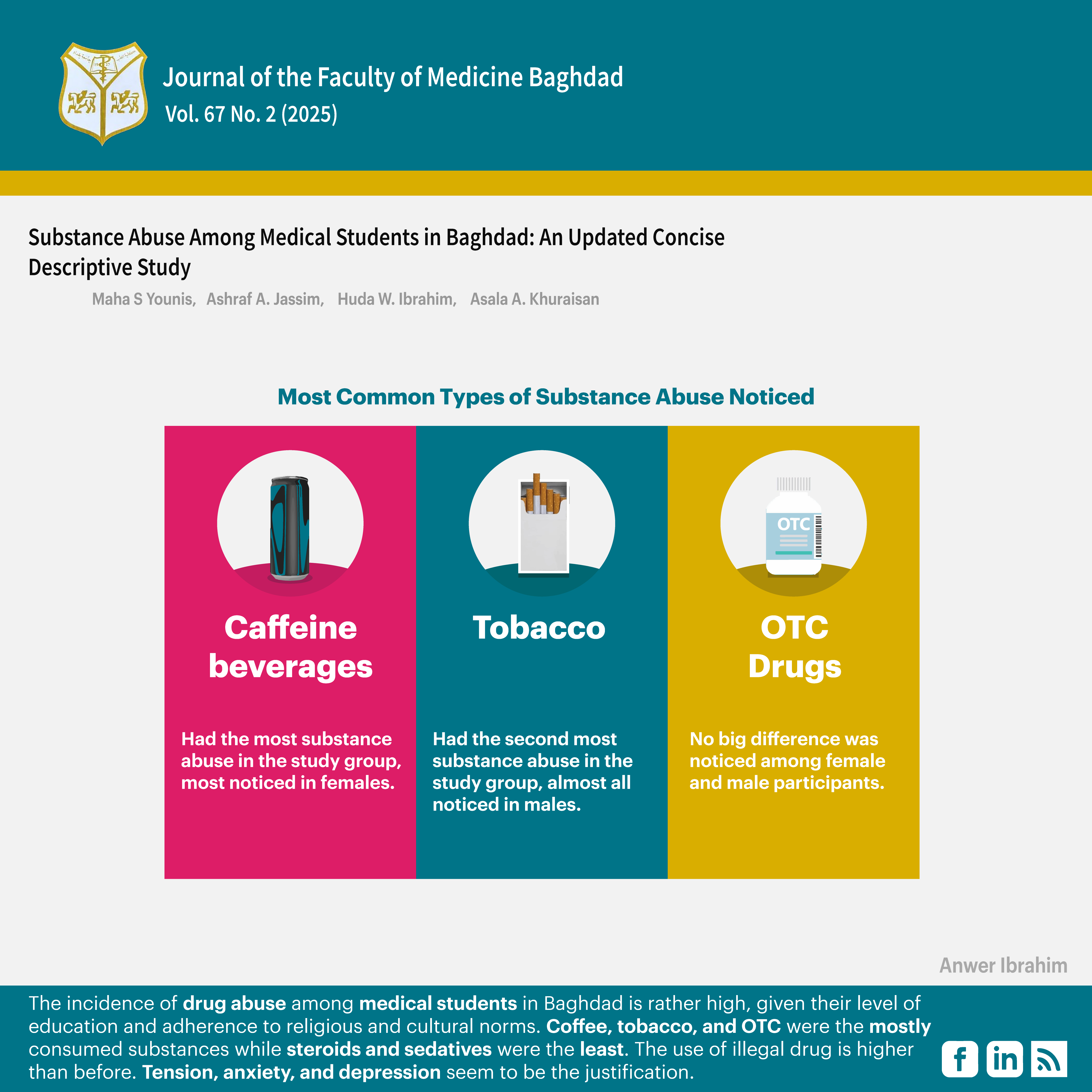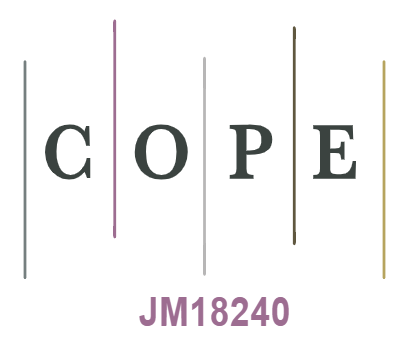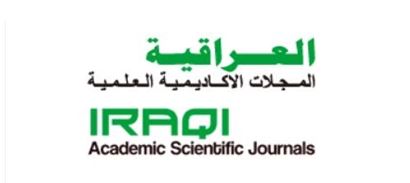Substance Abuse Among Medical Students in Baghdad: An Updated Concise Descriptive Study
DOI:
https://doi.org/10.32007/jfacmedbaghdad2429Keywords:
Anxiety, Baghdad, Depression, Substance abuse, Medical studentsAbstract
Background: Substance abuse can be defined briefly as the excessive and continuous consumption of psychoactive substances without medical supervision, leading to dependence and adverse health consequences. Substance abuse is an escalating and surging public health challenge in Iraq.
Objectives: To assess the frequency of substance abuse among a large group of senior undergraduate medical students and to identify the associated factors.
Methods: A convenience sample of 388 senior medical students from the College of Medicine/ University of Baghdad during April 2023 took part in this study. Itemployed a modified electronic version of the Drug Addiction Survey Questionnaire (DAST-20) with “yes or no” responses through the college's website anonymously. The survey format included questions about the type, quantity, and duration of abuse, the respondent’s gender and the causes of abuse. Three more questions about the use of alcohol, caffeine, and nicotine were added to the 20 original questions. This study was affiliated with the Department of Community Medicine
Results: Out of the 388 respondents, 212 students (54.6%) met the criteria for substance abuse according to the study tool. The substances reported to be used included caffeine beverages 94 (24.2%), tobacco (nicotine) 48 (12.3%), Benzodiazepines 23 (5.9%), over-the-counter (OTC) medicines 21 (5.4%), and steroids 8 (2%). Males reported greater rates of substance abuse for nicotine and illicit substances compared to females. Females had higher substance use rates for caffeine at the Baghdad College of Medicine.
Conclusion: The incidence of drug abuse among medical students in Baghdad is rather high, given their level of education and adherence to religious and cultural norms. Coffee, tobacco, and OTC were the most consumed substances, while steroids and sedatives were the least. The use of illegal drugs is higher than before. Tension, anxiety, and depression seem to be the justification
Received: Oct. 2024
Revised: Mar. 2025
Accepted: Sept. 2025
Published Online: Sept. 2025
References
1. World Health Organization (WHO). The global burden of substance abuse (2024). Available from: http://www.who.int/substance_abuse/facts/global_burden/en, Regional Office for the Eastern Mediterranean. https://iris.who.int/handle/10665/260374.
2. Vivek B, Tharu R. Psychoactive Substances/ Substance Abuse / Drug Abuse. Retrieved on 11 June. 2024) from: http://www.medindia.net.
3. Livne O, Shmulewitz D, Stohl M, Mannes Z, Aharonovich E, Hasin D. Agreement between DSM-5 and DSM-IV measures of substance use disorders in a sample of adult substance users." Drug and alcohol dependence 227. 2021, https://doi.org/10.1016/j.drugalcdep.2021.108958. DOI: https://doi.org/10.1016/j.drugalcdep.2021.108958
4. Kabbash I, Zidan O, and Saied Sh. Substance abuse among university students in Egypt: prevalence and correlates.EMHJ. 2022; 28: 31-40 0. https://doi.org/10.26719/emhj.22.001. DOI: https://doi.org/10.26719/emhj.22.001
5. Al‐Hemiery N, Dabbagh R, Hashim MT, Al‐Hasnawi S, Abutiheen A, Abdulghani E, et al. A. Self-reported substance uses in Iraq: findings from the Iraqi National Household Survey of Alcohol and Drug Use. J Addiction. 2017; 112(I8): 1470-1479. https://doi.org/10.1111/add.13800. DOI: https://doi.org/10.1111/add.13800
6. Allen HK, Lilly F, Green KM, Zanjani F, Vincent KB, & Arria AM. Substance use and mental health problems among graduate students: Individual and program-level correlates. JACH. 2022(70)1: 65-73, https://doi.org/10.1080/07448481.2020.1725020. DOI: https://doi.org/10.1080/07448481.2020.1725020
7. Younis MS, Hussain HY. The Prevalence and Pattern of Substance Use among Medical Undergraduates in Baghdad University: A Preliminary Report. The Arab Journal of Psychiatry. 2021. 32(1). https://doi.org/10.12816/0058766. DOI: https://doi.org/10.12816/0058766
8. Saeed B, Namiq O. Substance Use, Alcohol Consumption, and Smoking Prevalence Amongst Medical Students in Erbil, Iraq. Cereus. 2024. 16(5). https://doi.org/10.7759/cureus.60614. DOI: https://doi.org/10.7759/cureus.60614
9. Madhloom RS, Ali NS, Snell T. "Attitudes of Undergraduate Medical Students in Baghdad Toward Mental Disorders and People with Mental Health Difficulties. Arab Journal of Psychiatry 2020. 31(2): 144-149, https://doi.org/10.12816/0056865. DOI: https://doi.org/10.12816/0056865
10. Al-Gburi K, Abd Alridha AM, Abbood SK, Ali AB, & Salih AT. Tobacco smoking and substance use among medical undergraduates in Najaf, Iraq: prevalence and associated factors. Journal of Substance Use. 2024.29(3):412-422. https://doi.org/10.1080/14659891.2023.2173093. DOI: https://doi.org/10.1080/14659891.2023.2173093
11. Al Ansari M, Dawson A, Conigrave K. Alcohol among young people in Iraq: a systematic scoping review. Discover Psychology (2022), 2,16, https://doi.org/10.1007/s44202-022-00024-8. DOI: https://doi.org/10.1007/s44202-022-00024-8
12. Al-Naaimi A S, Younis MS. Assessment of religious and spiritual beliefs dimension of life quality in a sample of fifth-year medical college students of the University of Baghdad. J Fac Med Baghdad. 2010. 52 (4): 412-415, https://doi.org/10.32007/jfacmedbagdad.524944. DOI: https://doi.org/10.32007/jfacmedbagdad.524944
13. Al-Hasnawi S, Sadik S, Rasheed M, Baban A, Al-Alak MM, Othman AY, et al.. The prevalence and correlates of DSM-IV disorders in the Iraq Mental Health Survey (I.M.H.S.). J World Psychiatry 2009. 8(2): 97-109.
14. Mitesh K, Kandel D, Subedi N. Prevalence of substance abuse and its associated factors among medical students: a cross-sectional study." F1000Research 10. 2022: 797: 7. https://doi.org/10.12688/f1000research.54585.2. DOI: https://doi.org/10.12688/f1000research.54585.2
15. Al-Imam A, Motyka MA, Hoffmann B, Basil S, Al-Hemiary N. Suicidal ideation in Iraqi medical students based on research using PHQ-9 and SSI-C. International journal of environmental research and public health. 2023. 20(3) : 1795. https://doi.org/10.3390/ijerph20031795.
16. Alharbi F, Alsubaie EG, Al-Surimi Kh. "Substance abuse in the Arab world: does it matter and where are we?. Handbook of Healthcare in the Arab World. Cham: Springer International Publishing. 2021. 2371-2398, https://doi.org/10.1186/1747-597X-9-33. DOI: https://doi.org/10.1007/978-3-030-36811-1_179
17. Al Ateeq DA, Alotaibi R, Al Saqer R, Alharbi N, Alotaibi M, Musllet R, et al. Caffeine consumption, intoxication, and stress among female university students: a cross-sectional study. Middle East current psychiatry. 2021. 28(1)28. 30. https://doi.org/10.1186/s43045-021-00109-5. DOI: https://doi.org/10.1186/s43045-021-00109-5
18. Saddeh R. Caffeinated–Beverages Consumption Habits and Use among Medical Students in North Jordan. Jordan Medical Journal. 2019. 51. https://www.Archives.ju.edu.jo.
19. Kharaba Z, Sammani N, Ashour S, Ghemrawi R, Al Meslamani AZ, Al-Azayzih A, et al. . "Caffeine consumption among various university students in the UAE, exploring the frequencies, different sources and reporting adverse effects and withdrawal symptoms. Journal of Nutrition and metabolism, (2022),22,1: 5762299, https://doi.org/10.1155/2022/5762299. DOI: https://doi.org/10.1155/2022/5762299
20. Booth N, Saxton J, Rodda SN. Estimates of caffeine use disorder, Caffeine withdrawal, harm and help-seeking in New Zealand: a cross-sectional survey. Addictive Behaviours. 2020. https://doi.org/10.1016/j.addbeh.2020.106470. DOI: https://doi.org/10.1016/j.addbeh.2020.106470
21. Rogowska AM. The Relationship Between Demographic Variables and Substance Use in Undergraduates. Int J.Ment Health Addiction. 2019. 17, 1550–1563. https://doi.org/10.1007/s11469-018-9931-7. DOI: https://doi.org/10.1007/s11469-018-9931-7
22. Elfaki BA. Prevalence and factors influencing smoking among medical students. IJHS. 2023. 7: 525-535, https://doi.org/10.53730/ijhs.v7nS1.14234. DOI: https://doi.org/10.53730/ijhs.v7nS1.14234
23. Abbood SK, Abd Alridha AM, Al-Gburi KM, Mohsin NA, Ismael AS, Ali AB, Salih AT. Prevalence and Epidemiological Characteristics Associated with Hookah Smoking and Alcohol Consumption among Medical Students in Najaf, Iraq. MJBL. 2023.20(1). https://doi.org/10.4103/MJBL.MJBL_313_22. DOI: https://doi.org/10.4103/MJBL.MJBL_313_22
24. Salim ID. Study on prevalence of cigarette smoking among a sample of students of the technical institute of Babylon. Education. 2023: 3-4. https://doi.org/10.47391/JPMA.IQ-11. DOI: https://doi.org/10.47391/JPMA.IQ-11
25. Al-Imam A, Motyka MA, Mishaal M, Mohammad S, Sameer N, Dheyaa H. The Prevalence of Self-Medication with Painkillers Among Iraqi Medical Students. GJHS. 2020. 12 (7): 38-4. https://doi.org/10.5539/gjhs.v12n7p38 DOI: https://doi.org/10.5539/gjhs.v12n7p38
26. Khalil NS, Haddad RA, Hassan IT, Tawfeeq RS. Prevalence, practice, and pattern of self-medication among medical students in Al-Iraqiya Medical College, Baghdad, Iraq. Technology 2019. 39(3): 106-112. https://doi.org/10.25258/ijddt.v9i3.29. DOI: https://doi.org/10.25258/ijddt.v9i3.29
27. Mamcarz I, Biela A, Mamcarz P, Jurek K, & Dobrowolska B. The Risk of Self-medication among Students from Urban and Rural Areas. AJHB. 2021. 45(4): 625-634. https://doi.org/10.5993/AJHB.45.4.2. DOI: https://doi.org/10.5993/AJHB.45.4.2
28. Alshogran OY, Alzoubi KH, Khabour OF, & Farah S. Patterns of self-medication among medical and nonmedical University students in Jordan. Risk Management and Healthcare Policy. 2018. https://doi.org/10.2147/RMHP.S17018. DOI: https://doi.org/10.2147/RMHP.S170181
29. Mahmood N, Othman S, Al-Tawil N, Al-Hadithi T. Substance use among high school students in Erbil City, Iraq: prevalence and potential contributing factors. EMHJ. 2019. 25(11): 806-812. 812, https://doi.org/10.26719/emhj.19.022. DOI: https://doi.org/10.26719/emhj.19.022
30. Al-Ameri R, Abd Al-Badri HJ, Lafta RK. Prevalence of alcohol consumption among university students in Baghdad: a cross-sectional survey from Iraq. Epidemiol Biostat Public Health. 2016. 13 (4). https://doi.org/10.2427/11942. DOI: https://doi.org/10.2427/11942
31-Al Ansari M, Dawson A, Conigrave K. Alcohol: From Mesopotamia to modern Iraq. Journal of ethnicity in substance abuse. 2021. 20(3): 343-365. https://doi.org/10.1080/15332640.2019.1657541. DOI: https://doi.org/10.1080/15332640.2019.1657541
32. Muzil JA, Dhurgham A, Abdulwahid AH, Abed Z, Kammad A. Substance Abuse in Iraq: Quantifying the Picture. JPTCP. 2023. 30(12): 302–313. https://doi.org/10.47750/jptcp.2023.30.12.036. DOI: https://doi.org/10.47750/jptcp.2023.30.12.036
33. Al-Imam A, Al-Qassab Y, Younus M, & Michalak M. The ambiguity of psychedelics use among Iraqi medical students. Iraqi New Med. J. 2024. 10 (19) : 2-6, www.iraqinmj.com/upload/8606859512.
34. Younis MS, Al-Rubayee A. Attitude of Medical Students University of Baghdad toward psychiatry: Clinical significance and as future career, J Fac Baghdad. 2019. 60(4): 222-227, https://doi.org/10.32007/med.1936/jfacmedbagdad.v60i4.8. DOI: https://doi.org/10.32007/jfacmedbagdad.604433

Downloads
Published
Issue
Section
Categories
License
Copyright (c) 2025 Maha S. Younis, Ashraf A. Ahmed Jassim, Huda W. Ibrahim, Asala A. Khuraisan

This work is licensed under a Creative Commons Attribution 4.0 International License.










 Creative Commons Attribution 4.0 International license..
Creative Commons Attribution 4.0 International license..


